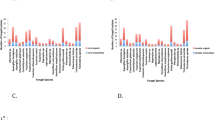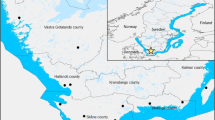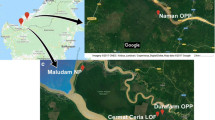Summary
Fungi occurring commonly in cut-away peat were selected for autecological study, being chosen to represent both cosmopolitan and indigenous elements of the peat flora. A fungus alien to peat,Fusarium culmorum, was also included in the study. The germination in peat of the spores of these species and their ability to grow and colonise organic material added to peat were examined. It was concluded that the cosmopolitan element was composed of efficient saprophytes but that the ability of their spores to germinate in unamended peat was limited. Although Fusarium spores germinated, the germ tubes subsequently formed chlamydospores. Only spores of the indigenous peat fungi germinated well in peat but their growth habit was not suited to the colonisation and utilisation of organic matter, added to peat, in competition with the cosmopolitan flora. The concept of ‘source potential’ is introduced to explain the variance in fungal growth from different substrate bases.
Similar content being viewed by others
References
Bruehl, G. W. and Lai, P., Prior colonisation as a factor in the saprophytic survival of several fungi in wheat straw. Phytapothol.56, 766–768 (1966).
Burges, N. A., Micro-organisms in the Soil. Hutchinson, London (1958).
Burges, N. A., Time and size as factors in soil ecology. J. Ecol.48, 273–285 (1960).
Bywater, J., Infection of Peas byFusarium solani var.martii forma 2 and the spread of the pathogen. Trans. Brit. Mycol. Soc.42, 201–212 (1959).
Dickinson, C. H. and Dooley, M. J., The microbiology of cut-away peat. I. Descriptive ecology. Plant and Soil27, 172–186 (1967).
Dickinson, C. H. and Boardman, F., The microbiology of cut-away peat. III. Physiological studies. (In press) (1970).
Dooley, M., The Microbiology of Cut-away Peat. Ph.D. thesis Dublin (1968).
Dooley, M. and Dickinson, C. H., The microbiology of cut-away peat. II. The ecology of fungi in certain habitats. Plant and Soil32, 454–467 (1970).
Garrett, S. D., Biology of Root-infecting Fungi. Cambridge U.P. (1956).
Gottlieb, D., Biosynthetic processes in germinating spores.In: The Fungus Spore, ed. Madelin, M. F. pp. 217–233. Butterworths, London (1966).
Griffin, D. M., Soil moisture and the ecology of soil fungi. Biol. Rev.38, 141–166 (1963).
Griffin, D. M., Soil physical factors and the ecology of fungi. IV. Influence of the soil atmosphere. Trans. Brit. Mycol. Soc.49, 115–119 (1966).
Jackson, R. M., Some aspects of soil fungistasis. J. Gen. Microbiol.19, 390–401 (1958).
Lockwood, J. L., Soil fungistasis. Ann. Rev. Phytopathol.2, 341–362 (1964).
Manners, J. G., Assessment of germination.In: The Fungus Spore ed. Madelin, M. F. pp. 165–173. Butterworths, London (1966).
Newcombe, M., Some effects of water and anaerobic conditions onFusarium oxysporum f.cubense in soil. Trans. Brit. Mycol. Soc.43, 51–59 (1960).
Park, D., Behaviour of soil fungi in the presence of fungal antagonists. Trans. Brit. Mycol. Soc.39, 239–259 (1956).
Park, D., The saprophytic status ofFusarium oxysporum Schl. causing vascular wilt of oil palm. Ann. Bot. (N.S.)22, 19–35 (1958).
Park, D. and Robinson, P. M., Isolation and bioassay of a fungal morphogen. Nature203, 988–989 (1964).
Sadasivan, T. S., Succession of fungi decomposing wheat straws in different soils with special reference toFusarium culmorum. Ann. Appl. Biol.26, 497–508 (1939).
Skinner, F. A., A technique for distinguishing between viable spores and mycelial fragments of actinomycetes in soils. J. Gen. Microbiol.5, 159–166 (1951).
Steel, R. G. D. and Torrie, J. H., Principles and Procedures of Statistics. McGraw-Hill Book Co., New York (1960).
Stotzky, G. and Goos, R. D., The effect of high CO2 and low O2 tensions on the soil microbiota. Can. J. Microbiol.11, 853–868 (1965).
Trinci, A. P. J. and Whittaker, C., Self-inhibition of spore germination inAspergillus nidulans. Trans. Brit. Mycol. Soc.51, 594–596 (1968).
Walker, A. G., The colonisation of buried wheat straw by soil fungi, with special reference toFusarium culmorum. Ann. Appl. Biol.28, 333–350 (1941).
Warcup, J. H., Studies on the occurrance and activity of fungi in a wheat-field soil. Trans. Brit. Mycol. Soc.40, 237–262 (1957).
Author information
Authors and Affiliations
Rights and permissions
About this article
Cite this article
Dooley, M. The microbiology of cut-away peat. Plant Soil 33, 145–160 (1970). https://doi.org/10.1007/BF01378207
Received:
Issue Date:
DOI: https://doi.org/10.1007/BF01378207




